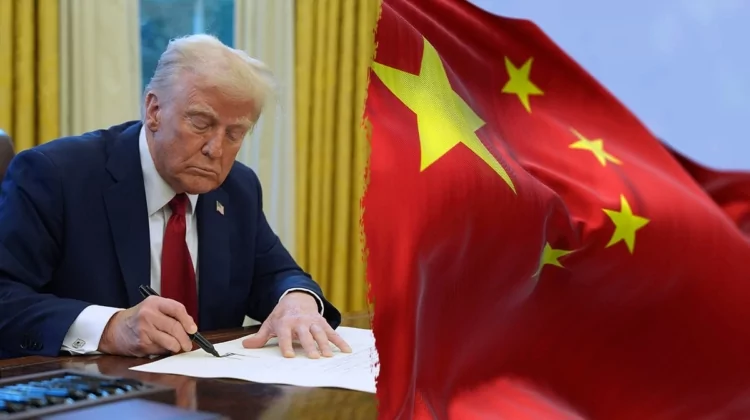Trump Confronts Cheating China
The CCP finally gets its comeuppance.

|
Getting your Trinity Audio player ready...
|
[Want even more content from FPM? Sign up for FPM+ to unlock exclusive series, virtual town-halls with our authors, and more—now for just $3.99/month. Click here to sign up.]
The United States and China are engaged in an escalating tit-for-tat trade war that will harm both countries’ economies. The smart money should be on the United States to eventually come out on top.
President Trump kicked off the current round of tariff increases, most noticeably with his reciprocal tariffs that he imposed on imports from virtually all U.S. trading partners. He then raised the total tariffs on goods imported from China to 104 percent at midnight on April 9th after China ignored the president’s warning to rescind its own retaliatory 34 percent tariff on imports of U.S. goods. The Chinese regime did not get the message. Instead of stepping back and reducing its tariffs and onerous trade barriers, the regime doubled down and raised its tariffs on U.S. goods again to 84 percent. President Trump then upped the ante once more and promptly raised the tariff on imports of Chinese goods into the United States to 145 percent. China retaliated yet again by raising its tariffs on U.S. goods exported to China to 125 percent.
President Trump has already gained an advantage by isolating China. The president kept in effect the exceedingly high tariffs he imposed on Chinese exported goods, while pausing for ninety days the reciprocal tariffs on America’s other trading partners that had not retaliated like China did.
Mr. Trump did not pause the baseline 10 percent tariff he had imposed on imports from virtually all of America’s trading partners or the 25 percent tariffs that he had imposed on imports of automobiles, steel, and aluminum. Nevertheless, his pause on reciprocal tariffs for all trading parties willing to enter one-on-one negotiations in good faith with the Trump administration allows them to do so without the sword of Damocles hanging over their heads. The Chinese regime, on the other hand, has chosen the path of defiance rather than conciliation. It will reap the consequences unless and until it demonstrates with concrete actions that it is serious about curbing its unfair trading practices.
On April 11th, China did get some relief when the Trump administration announced a narrowly crafted exemption from its tariffs to avoid a sudden destabilizing shock to America’s economically vital high-tech sector that is years away from self-sufficiency. Smartphones, laptops, hard drives, flat-panel monitors, chips, and machines used to make semiconductors are exempted from the current 145 percent tariffs levied on China and from the 10 percent baseline tariffs levied on America’s other trading partners.
However, China should not get too complacent or assume that President Trump has blinked first. The president is providing China a face-saving exit ramp to bring its tariffs on U.S. exports back down significantly but retains the option to reinstate his 145 percent tariff on Chinese exports of electronics as he sees fit. Moreover, China is still facing the 145 percent tariff imposed on all other goods that it exports to the United States such as toys, furniture, textiles and clothing, plastic products, construction machinery, transportation equipment, and home appliances. These exports are worth hundreds of billions of dollars, which China will lose if it continues its escalating trade war with the U.S.
China does have some leverage that it can exert in an all-out trade war with the United States. China’s advantages include its control of some vital rare minerals and components needed for advanced technological products. The regime has already suspended exports of certain rare minerals and magnets needed by such companies as automakers, aerospace manufacturers, and military contractors. China also has a chokehold today on supply chains of certain critical products Americans require such as pharmaceuticals, and it owns an estimated $972 billion of U.S. Treasuries that it can sell into the global market.
However, the U.S. economy today is far sturdier than China’s and is better able to withstand the headwinds from an escalating trade war. Moreover, President Trump’s trade policies are designed to reduce U.S. dependencies on China and other foreign sources of supply as well as to sharply lower the U.S.’s current massive trade deficit with China. The president’s plan is to rebuild America’s own manufacturing capacity that globalists had allowed to erode for decades, and to move towards a balanced budget by significantly cutting government spending plagued by waste, fraud, and abuse.
On the other hand, China has put itself into a deep hole that may be exceedingly difficult for the regime to crawl out of. Its huge overreliance on its export market for economic growth at the expense of its own domestic consumers may become the regime’s undoing if it persists in an escalating trade war with the United States. As the New York Times explained, “China is exporting so much partly because its own people are buying so little. A housing market crash since 2021 has wiped out much of the savings of the middle class and ruined many wealthy families.”
To bolster China’s flagging economy, the Communist regime has placed virtually all its bets on developing a supercharged export market. It has invested heavily on building or expanding factories to produce enormous amounts of state-subsidized products for export, especially to the United States. Since the United States has been China’s largest market for its exports, President Trump’s 145 percent tariff on China’s exports to the U.S. will result in stranded inventory stockpiles and unused manufacturing capacity that will devastate China’s economy.
As Treasury Secretary Scott Bessent explained to reporters at the White House, President Trump has “created maximum negotiating leverage for himself,” while the Chinese have “shown themselves to the world as the bad actors.”
Nevertheless, Chinese President Xi Jinping has decided to go all in. In addition to China’s increases of its tariffs on imported American goods to 125 percent, Chinese authorities have announced that the regime would impose more restrictions on trade between U.S. and Chinese companies. “If the U.S. insists on further escalating its economic and trade restrictions, China has the firm will and abundant means to take necessary countermeasures and fight to the end,” the Ministry of Commerce declared.
In a desperate display of shameless hypocrisy, this trade cheat also intends to launch another of its frivolous complaints against the U.S. at the World Trade Organization (WTO).
Globalists like Joe Biden created the problem of the U.S.’s massive trade imbalance with China in the first place when they supported China’s entry into the WTO in December 2001. Globalists proceeded on the false premise that China’s integration into an open global market, providing China with the opportunity to significantly improve its economy, would encourage China to move towards democracy and respect for human rights.
In July 2000, during a Senate Foreign Relations Committee hearing on giving permanent normal trade relations status to Communist China, then-Senator Joe Biden asserted as a foregone conclusion that “granting permanent normal trade relations to China has little to do with our national security. It does not increase their access to controlled U.S. technology. It does not increase their access to our markets.” Biden claimed that bringing the Chinese regime into contact with the international norms of the WTO “is the best way to get China to clean up its act.”
At the opening of the third session of the U.S.-China Strategic & Economic Dialogue in May 2011, then-Vice President Biden said that “a rising China is a positive, positive development, not only for China but for America and the world writ large.”
Joe Biden was as grievously wrong then as he was during his failed presidency. The Chinese Communist autocracy did not clean up its act. It became even more repressive. The regime broke its commitments upon accession to the WTO not to provide export subsidies, to remove non-tariff trade barriers, and to substantially reduce tariffs on industrial and agricultural goods of importance to U.S. businesses and farmers. The Chinese regime’s massive subsidization of China’s manufacturing sector has led to Chinese producers being able to dump below cost goods into the U.S. market, forcing domestic producers who cannot compete with Chinese exporters’ cheap prices out of business. Thriving U.S. communities turned into ghost towns as millions of American workers lost their jobs.
China has also brazenly violated the WTO agreement it had accepted relating to international intellectual property protection norms by regularly stealing U.S. intellectual property. China is the world’s leading den of intellectual property thieves.
In short, as former assistant director of intelligence for the FBI Kevin R. Brock observed in an article he wrote for The Hill, “China largely has cheated its way to prosperity.”
Over the course of more than twenty years since China became a member of the WTO and cheated its way to prosperity, the U.S. trade deficit with China has ballooned exponentially. Successive U.S. presidents from both parties have aided China’s exploitation of the global trading system by pursuing incredibly lenient globalist trading policies towards China.
President Trump is finally putting an end to this economic malpractice by ignoring the globalists’ advice not to punish China too harshly for its many misdeeds. Instead, he is holding China to account while giving other countries that are willing to negotiate in good faith time to reach acceptable trade agreements with the United States. And President Trump is keeping his campaign promise to pursue a robust reindustrialization of America as part of his America First policies.

